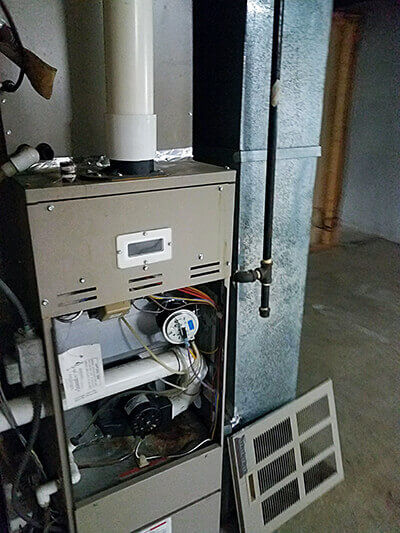8 Ways to Stay Warm This Winter
Staying warm during the frigid months of winter is essential for your health and safety. Though many people think a furnace is the only way you can heat your home, there are actually a wide variety of options for every home and lifestyle. Check out this variety of eight heating options you can utilize this winter that range from traditional whole-home HVAC systems to smaller, more portable options.
1. Gas Furnace
When you think about heating your home, a gas furnace is probably what comes to mind. A popular heating method in the United States, gas furnaces work by taking cold air into the system and heating it with a gas burner. After it’s been heated, the air is then circulated throughout your home via a forced-air system.
Newer furnaces are energy efficient and easy to maintain with proper tune-ups each fall. They’re a time-tested heating method you can count on, although you might want to consider a replacement if your current furnace is older than a decade or so. This is because newer models heat much more efficiently than ones of the past did.
2. Electric Furnaces
Electric furnaces are another common home heating method that functions very similarly to a gas furnace. Instead of using a gas burner to heat the cool air it draws in, an electric heating component similar to that found in a hairdryer heats it and then circulates it throughout the home.
An electric furnace offers a few advantages over gas. There isn’t combustion going on, making it a bit of a safer option. Because of this lack of combustion gasses, no venting is needed. This makes new furnace installation easier since you’re not so constricted when it comes to placement.
3. Geothermal Heating
Geothermal heating and cooling used to be reserved for those who had a lot of discretionary spending money. Once considered a luxury, geothermal heating is quickly becoming more accessible to the general public. Though the installation costs can still seem steep when compared to a furnace or similar heating method, the benefits more than compensate for the difference in cost.
Unlike furnaces, geothermal systems don’t have to heat cool air in order to function. Instead, they draw upon heat underground using a heat exchanger to transfer this heat into usable warmth for your home. Since the ground remains at a fairly steady temperature year-round, a geothermal system works for both heating and cooling your home.
Another benefit to going geothermal is the total system lifespan. A furnace will function for around a decade and sometimes up to 15 years. A geothermal system, however, will last 20 years or longer.
4. Air-Source Heat Pumps
A heat pump is similar to a geothermal system in one key way: it works to both heat and cool your home. In the summer, heat pumps take warm air from inside your home and then pump it outside. In the cold months, these devices work by pulling warmth out of the air outside and pumping it into your home. Because of this, heat pumps only work well in climates that don’t see extremely low temperatures. When temps fall well below freezing, a backup heating source is utilized. Other than this drawback, air-source heat pumps are an efficient way to maintain the temperature in your home.
5. Mini- and Multi-Split Heat Pumps
An air-source heat pump isn’t the only type of heat pump out there. In addition to standard and cold climate air source heat pumps, there are also mini- and multi-split heat pumps. They work differently than air source heat pumps by the use of “heads” installed throughout your home.
Each head is a separate heating and cooling system attached to an efficient outdoor compressor unit. They can be easily installed in any room of your home, allowing you to have different temperatures set for different areas of the home. One head being installed is a mini-split system, whereas multiple create a multi-split. These heat pumps are efficient and convenient ways to heat your home since the lack of ductwork required makes installation easy. They’re perfect for small spaces like offices and apartments.
6. Cold Climate Air-Source Heat Pumps
Most air-source heat pumps have a set point temperature. After this level is hit, an alternative heating source is used. This set point temperature is often not much below freezing, leading to problems on exceptionally cool nights.
If you’re more interested in a heating system that does it all, consider a cold climate air-source heat pump. Unlike a standard model that stops operation around 30 degrees or so, a cold climate pump will often function at temperatures as low as five degrees. Sacramento nights rarely dip below this threshold, making a cold climate air-source heat pump a viable option for heating your home this winter.
7. Boilers
Boilers were once a common method to heat a home, but they’ve waned in popularity. With newer, more energy-efficient models, they’re seeing a recent uptick and coming back more into the mainstream. Old boilers were nowhere near as efficient as they are today. Though an energy-efficient furnace may have an efficiency rating of 95% or more, a new boiler will provide a more modest 85% efficiency rate or so.
Instead of using forced air that travels through ductwork installed in your home, a boiler heats an area using radiant heat. It’s just what it sounds like: heat radiates off the boiler and warms objects in the rooms near it. This radiant heat can sometimes make a space feel warmer and cozier than a standard furnace, a huge reason that some people still have a preference for boilers. Though they’re not common in homes anymore, they’re still often used in commercial properties like schools and manufacturing facilities.
8. Wood-Burning Heating System
If you think that the radiant heat from a boiler system sounds nice and cozy, a wood-burning heating system is something you should consider as well. Though you could go old school and have a wood-burning stove installed, there are now options that allow you to more easily and conveniently heat your home with wood.
A standard wood-burning stove is a pretty inefficient way to heat a space due to the warm air being sucked back up and out of the vent into the outdoors. A sealed wood-burning system is more efficient, but you still often need a backup heating system installed.
If you live on an acreage with lots of wood naturally available to you, this is a fantastic heating system that won’t cost much to run all winter round. If you live in the city and don’t have much access to free wood, this probably isn’t the most efficient heating system option available for you.
If you want to know more about your heating options in Sacramento, Crystal Blue Plumbing, Heating, & Air is the place to call. We offer a wide range of heating services for a variety of systems, including heat pumps, boilers, and furnaces. We are also a full-service plumbing and ductwork company. Give us a call today, and we’ll be happy to assist you!







